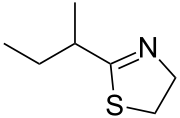2-sec-Butyl-4,5-dihydrothiazole
2-sec-Butyl-4,5-dihydrothiazole (also known as SBT) is a thiazoline compound with the molecular formula C7H13NS. A volatile pheromone found in rodents such as mice and rats, SBT is excreted in the urine and promotes aggression amongst males while inducing synchronized estrus in females.[2]
 | |
| Names | |
|---|---|
| IUPAC name
2-(Butan-2-yl)-4,5-dihydro-1,3-thiazole | |
| Other names
SBT 2-(1-methylpropyl)-2-thiazoline | |
| Identifiers | |
3D model (JSmol) |
|
| ChemSpider | |
PubChem CID |
|
CompTox Dashboard (EPA) |
|
| |
| |
| Properties | |
| C7H13NS | |
| Molar mass | 143.25 g·mol−1 |
| Density | 1.06 g/cm3 |
| Boiling point | 193 °C (379 °F; 466 K) |
| Hazards | |
| Flash point | 70.5 °C (158.9 °F; 343.6 K) |
Except where otherwise noted, data are given for materials in their standard state (at 25 °C [77 °F], 100 kPa). | |
| Infobox references | |
Binding to MUP
Mouse major urinary proteins (MUPs) are responsible for binding to hydrophobic ligands such as the pheromone SBT. SBT binds within MUP-I's barrel-shaped active site, forming a hydrogen bond with a water molecule within the active site, which in turn is stabilized by forming hydrogen bonds with residue Phe56 and another water molecule; this second water molecule also forms hydrogen bonds to residues in the active site, namely Leu58 and Thr39. SBT also forms van der Waals forces with several of MUP-I's residues, including Ala121, Leu123, Leu134, Leu72, Val100, and Phe108.
When bound, MUP safely carries SBT through the aqueous environment; once the protein-ligand complex is excreted in the urine, MUP helps prevent SBT decomposition and controls the slow release of SBT over a prolonged period of time, resulting in the physiological and behavioral responses of animals who come into contact with the pheromone. [3]
Synthesis
SBT can be produced from 3-(2-aminoethanethio)-4-methylhex-2-enenitrile;[4] however, it is also possible to synthesize SBT from ethanolamine and 2-methylbutanoic acid, using Lawesson's reagent and microwave irradiation.[5]
References
- CID 162148 from PubChem
- Perez-Miller, Samantha; Zou, Qin; Novotny, Milos V.; Hurley, Thomas D. (2010). "High resolution X-ray structures of mouse major urinary protein nasal isoform in complex with pheromones". Protein Science. 19 (8): 1469–79. doi:10.1002/pro.426. PMC 2923500. PMID 20509168.
- Timm, David E.; Baker, L.J.; Mueller, Heather; Zidek, Lukas; Novotny, Milos V. (2001). "Structural basis of pheromone binding to mouse major urinary protein (MUP-I)". Protein Science. 10 (5): 997–1004. doi:10.1110/ps.52201. PMC 2374202. PMID 11316880.
- Landor, S (1984). "Allenes-41 the addition of thiols to allenyl- and phenylpropynyl- nitrile and the formation of thiazolines and benzothiazoles". Tetrahedron. 40 (11): 2141. doi:10.1016/S0040-4020(01)88457-X.
- Seijas, Julio A.; Vázquez-Tato, M. Pilar; Crecente-Campo, José (2008). "Straightforward microwave-assisted synthesis of 2-thiazolines using Lawesson's reagent under solvent-free conditions". Tetrahedron. 64 (39): 9280. doi:10.1016/j.tet.2008.07.027.